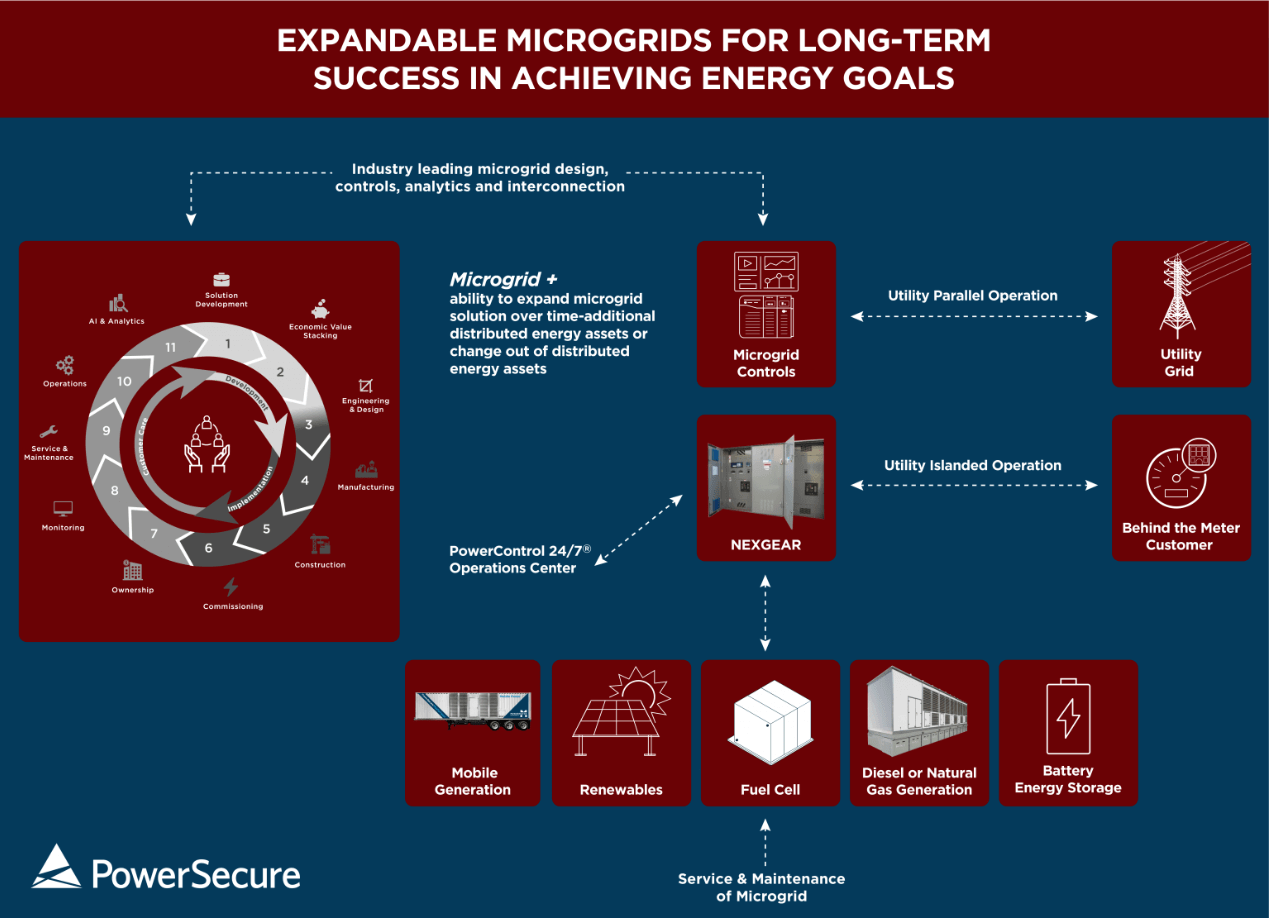How Can Microgrids Be Future-Proofed?
Eric Dupont, chief development officer at PowerSecure, explains how working with a microgrid+ developer can ensure microgrids are future-proof.

Over the last few years, microgrid deployments have increased throughout the world.
As more companies commit to reaching ESG goals and boosting resiliency, we should expect this trend in microgrid growth to continue. This growth will also likely lead to more government policies that incentivize the adoption of microgrid technology.
While more companies and communities install microgrids, it’s essential their microgrid systems can adapt to future innovations, minimizing future costs and avoiding stranded investments. If you’re interested in investing in a microgrid, it’s essential to understand why they’re the future of energy management and how they can be created to scale with new technology and fuels.
Why Are Microgrids the Future of Energy Management?
Having a consistent source of power at your facility is essential to many businesses and organizations. Without a microgrid, facilities have to rely on the main grid for all their power needs. Unfortunately, main grids can fail due to severe weather, human error, equipment breakdowns, planned maintenance, and other emergencies.
Microgrids are generation and energy storage facilities designed to achieve customer-specific requirements and objectives. As a local cluster of energy resources, they can operate continuously and independently for at least 24 hours, meaning they can provide power in the event of a main grid failure. Most microgrids also utilize green-energy distributed energy resources (DERs), such as wind turbines, solar panels, and natural gas generators, to provide a source of clean energy to facilities.
Alongside serving as a source of backup power, microgrids with grid-connected capabilities can export energy and improve the power quality of the local grid. When the grid is under strain or needs flexibility to balance resources, microgrids can autonomously support the host customer.
Since microgrids can lower energy costs, improve energy resilience, and support green-energy initiatives, they’ve become a critical part of energy management strategies. The future of microgrids will continue hand in hand with energy management needs, ensuring facilities have low-cost energy and a reliable, independent source of power in the event of main grid failure.
How Do You Future-Proof Microgrids?
Despite being the future of energy management, microgrids must be designed with scalability in mind. As you consider a new microgrid, you can receive the most future-proofed microgrid possible by choosing a microgrid+ system. These microgrids can transition seamlessly from a basic to an advanced microgrid with inherent controls that enable a reliable interface and interaction with the utility grid, energy markets, and end customers.
In the next wave of the energy evolution, businesses will require technologies that better protect an end-user’s investment in their assets. This expectation will enable more flexible, expandable solutions that also support newer technologies for a greener, cleaner, and more resilient microgrid experience. With a microgrid+ installed at your facility, you can meet these expectations, strategically forge ahead, build for your energy future, and protect current and future assets.
Additionally, while many businesses are thinking ahead toward their 2030 or 2040 net zero goals — and awaiting fuels to become cleaner, more cost-effective, and widely available — the technology to get to net zero is here today. Diversified renewable fuels are drop-in-ready solutions that can be used as a part of a total microgrid development and clean energy strategy. A future-proofed microgrid will utilize these flexible fuels to help businesses accelerate their path to net zero while preparing them to adapt more easily to new technologies.
Is There a One-Sized Fits All Solution for Future-Proofed Microgrids?
Given the evolving energy landscape and the need to design for both short-term and long-term business growth, a microgrid+ developer ensures that the core infrastructure of the microgrid is standardized and the underlying DERs are selected to support the customer’s business objectives. Due to the differences in customers’ objectives and the challenges that can arise from them, future-proofed microgrids can be uniquely different and provide many different benefits.
A microgrid+ developer approaches customers’ needs using a well-rounded integrated delivery model. Beginning with concept and design, the care for each microgrid extends far beyond building and implementation. As an evolving and flexible system built to be a long-term asset, each microgrid needs custom care. This custom care can be accomplished through lifetime technology assessments and ongoing monitoring and maintenance.

What Types of Fuel Should Future-Proofed Microgrids Use?
While microgrids typically contain DERs that don’t rely on fuel, such as solar panels and wind turbines, they’ll also usually employ gas generators. These generators are designed to improve the microgrid’s reliability, as environmental conditions and other factors can affect how much energy wind turbines and solar panels generate. To avoid a loss of power due to factors outside of their control, many companies choose to employ generators that run on fuel.
As a result, you can find various debates about whether to use natural gas vs. Tier 4 Final ultra-clean diesel engines. However, the reality is that all DERs add value, and there is a use for each of them, even in microgrids designed for the future. At PowerSecure, the conversation has been further broadened around fuel-agnostic microgrids that have the flexibility to future-proof the microgrid system. After all, the asset can last for 20 years.
Over time, microgrids with fuel flexibility will be valuable since technological improvement and innovation will allow our microgrids to work with a variety of low- to no-carbon options. If you’re designing a new microgrid, it’s best to work with a microgrid+ developer committed to providing their customers with dependable solutions that support all future fuel technologies. Doing so will help enhance the value of the microgrid and eliminate risk.
What Role Do Renewable Fuels Play in the Future of Microgrids?
Renewable natural gas and renewable diesel are currently available for customers in the U.S. and internationally. It’s important to make adopting renewable fuels easy with drop-in ready fuels. This ability to easily utilize renewable fuels means clients can switch to them without making costly and time-consuming upgrades and changes to existing assets. However, without incentives and other benefits, renewable fuels often come at a premium cost.
Despite their current higher costs, the world’s relationship with energy is rapidly changing, and organizations must prepare for the future of energy. As a result, it’s essential that your microgrid developer can define and deliver expandable, flexible, and clean microgrids that can adapt to energy evolution. These future-proofed microgrids can also eliminate risk for companies while enabling them to achieve their energy goals for a cleaner future today.
Turn to PowerSecure for Scalable Microgrids
The ability to create and utilize scalable technology is essential to the future of microgrids, and at PowerSecure, we understand the need for scalability. As a microgrid+ developer, our basic microgrids are designed with scalability in mind, ensuring you can upgrade your microgrid as your energy needs and the energy management industry evolves. Whether it’s through our use of AI, renewable fuels, clean-energy DERs, or energy-monitoring solutions, our microgrids are designed for the future.
Learn more about our advanced microgrids today. If you have any questions or want to find out more about how we create future-proofed microgrids, please contact us.
Eric Dupont is chief development officer at PowerSecure.
A version of this article was originally published by Microgrid Knowledge in August 2022.


